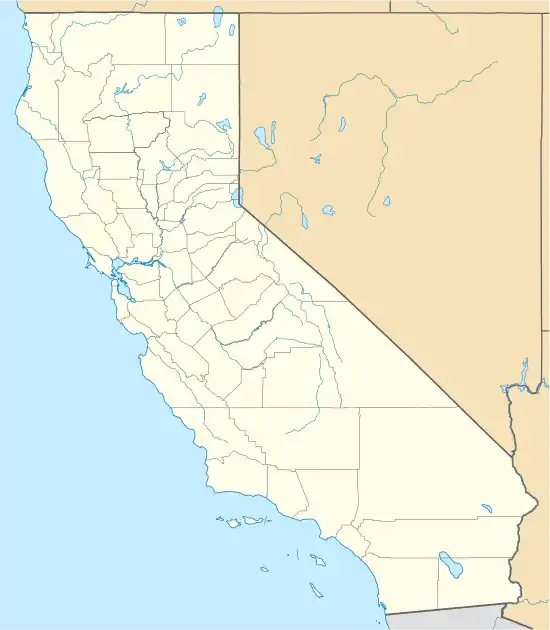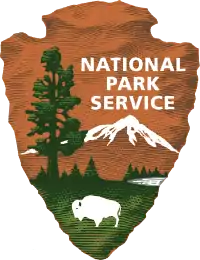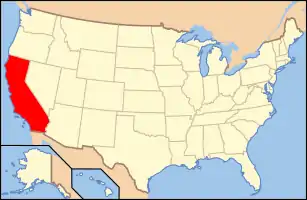José Castro House
The José Castro House, now known as the Castro-Breen Adobe, in San Juan Bautista, California, USA, is a historic Monterey Colonial adobe home built by José Antonio Castro in 1840. Castro was Commandant General of Alta California. In 1848 Castro sold the house to Patrick Breen, survivor of the ill-fated Donner party of 1846, and the Breen family lived in the house until 1935. They sold it to the State of California who adapted it as a museum and incorporated it into the San Juan Bautista Plaza Historic District.
José Castro House | |
 José Castro House | |
  | |
| Location | S side of the Plaza, San Juan Bautista, California |
|---|---|
| Coordinates | 36°50′40.78″N 121°32′4.86″W |
| Area | 1 acre (0.40 ha) |
| Built | 1841 |
| Architect | José Antonio Castro |
| Architectural style | Monterey Colonial |
| Part of | San Juan Bautista Plaza Historic District (ID69000038) |
| NRHP reference No. | 70000141[1] |
| CHISL No. | 179 |
| Significant dates | |
| Added to NRHP | April 15, 1970[1] |
| Designated NHL | May 15, 1970[2] |
| Designated NHLDCP | April 15, 1970 |
| Designated CHISL | March 6, 1935[3] |
Origins
José Antonio's father José Tiburcio Castro was a soldier, member of the diputacion (Alta California legislature),[4] administrator of Mission San Juan Bautista after it was secularized, and grantee of Rancho Sausal. The elder Castro used his position to obtain land grants for relatives and friends. His son was granted land on the San Juan Bautista plaza, where he built an adobe house in 1841. José Antonio Castro used the house as an administrative base for his military operations (soldiers' barracks were next door) and let his secretary use it as a residence.[5]
Architecture
The house, also known as the Castro-Breen Adobe, is a two-story Monterey Colonial-style adobe, and includes the characteristic second-story full-length covered porches on both long sides. The style of architecture originated in California, blending Spanish colonial architecture with New England style. Massachusetts native Thomas O. Larkin built the first known Monterey-style house in 1835 in Monterey, California. Adding a wood frame in the adobe walls allows for more windows than traditional adobe construction, and can support a second floor. In the Monterey style, the porches and extended roof eaves protect the adobe bricks and outer shell from water damage. The pane glass windows beside the front door of the José Castro House are not typical of Monterey architecture and reflect the influence of Greek Revival architecture, which was also popular in the mid-19th century. Today, the José Castro House property includes a half-acre orchard and garden.[5]
Current uses
San Juan Bautista State Historic Park uses the José Castro House as a fully furnished museum, where visitors are welcome to explore and see what the inside of the house looked like in the mid-19th century. Several other historic buildings in the plaza that are part of the San Juan Bautista Historic District are also open to the public. These buildings include the San Juan Bautista Mission, Plaza Hotel, and Zanneta House. The park offers guided tours of the plaza, a gift shop in the Plaza Hotel, costumed re-enactments every first Saturday of the month, and activities for children. The San Juan Bautista Mission is a stop on the Juan Bautista de Anza National Historic Trail.[5]
Landmark status
The Jose Castro House was declared a California Historical Landmark in 1935[3] and a National Historic Landmark in 1970.[2][6] It is part of the San Juan Bautista Plaza Historic District, which is itself a National Historic Landmark District. The house has been open to the public since 1935.[1]
References
- "National Register Information System". National Register of Historic Places. National Park Service. July 9, 2010.
- "José Castro House". National Historic Landmark summary listing. National Park Service. Archived from the original on 2007-11-14. Retrieved 2007-11-17.
- "Castro House". Office of Historic Preservation, California State Parks. Retrieved 2012-10-11.
- Killea; Lucy Lytle (October 1966). "Journal of San Diego History". San Diego Historical Society. sandiegohistory.org. Retrieved 16 June 2010.
- "José Castro House San Juan Bautista, California". U.S. National Park Service. Retrieved 26 August 2016.
- James Dillon (April 5, 1976). "National Register of Historic Places Inventory-Nomination:" (pdf). National Park Service. Cite journal requires
|journal=(help) and Accompanying 2 photos, exterior, from 1968. (465 KB)
External links
- Historic American Buildings Survey (HABS) No. CA-1120, "General José Castro House, Mission Plaza, San Juan Bautista, San Benito County, CA", 31 photos, 2 color transparencies, 4 photo caption pages
This article incorporates content in the public domain from the U.S. National Park Service.

